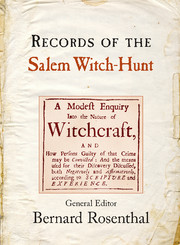Book contents
- Frontmatter
- Dedication
- Contents
- Associate Editors
- Acknowledgments
- I LIST OF FACSIMILE PLATES
- II GENERAL INTRODUCTION
- III LEGAL PROCEDURES USED DURING THE SALEM WITCH TRIALS AND A BRIEF HISTORY OF THE PUBLISHED VERSIONS OF THE RECORDS
- IV LINGUISTIC INTRODUCTION
- V EDITORIAL PRINCIPLES
- VI CHRONOLOGICAL ARRANGEMENT
- VII RECORDS OF THE SALEM WITCH-HUNT
- Timeline: Court of Oyer & Terminer and Superior Court of Judicature
- Biographical Notes
- Works Cited
- Indexes: Introduction
- Names Included in Document Titles
- Concordance of Names
V - EDITORIAL PRINCIPLES
Published online by Cambridge University Press: 25 October 2017
- Frontmatter
- Dedication
- Contents
- Associate Editors
- Acknowledgments
- I LIST OF FACSIMILE PLATES
- II GENERAL INTRODUCTION
- III LEGAL PROCEDURES USED DURING THE SALEM WITCH TRIALS AND A BRIEF HISTORY OF THE PUBLISHED VERSIONS OF THE RECORDS
- IV LINGUISTIC INTRODUCTION
- V EDITORIAL PRINCIPLES
- VI CHRONOLOGICAL ARRANGEMENT
- VII RECORDS OF THE SALEM WITCH-HUNT
- Timeline: Court of Oyer & Terminer and Superior Court of Judicature
- Biographical Notes
- Works Cited
- Indexes: Introduction
- Names Included in Document Titles
- Concordance of Names
Summary
TEXT
In editing the records of the Salem witch-hunt that survive in manuscripts, the leading principle has been to reproduce the text as it appears in the original documents as faithfully as possible, given the limitations of modern typography. Accordingly, the spelling and punctuation used by the original recorders have been retained, including their use of capital letters and abbreviations. The following exceptions apply to this general rule:
(A) Spelling
Prefixes and other elements that are separated from the rest of the word in the original documents have not been kept separate in the edition (e.g., “in structed” > “instructed,” “re ward” > “reward,” “likly hode” > “liklyhode,” “a cording ly” > “acordingly”). Correspondingly, articles and prepositions that are attached to their headword in the original documents have been separated (e.g., “ablack” > “a black,” “ofland”> “of land”). These spellings have not been kept since they have been considered idiosyncratic. Moreover, it is often difficult to determine whether or not the recorder intended the elements to be written together. (See also the Linguistic Introduction, Section 4.)
(B) Punctuation
In the following three cases, punctuation marks found in the documents have not been retained in the edited text (see also the Linguistic Introduction, Section 4):
(1) dots and colons placed below superscript letters in abbreviations;
(2) single or double hyphens in word divisions at line breaks;
(3) dashes used as line-fillers.
(C) Capitalization
(1) Where there is ambiguity in interpreting whether a letter is a capital or a minuscule, capitals have been used in proper names and at the beginning of paragraphs; on all other occasions (including sentence boundaries), minuscules have been used (see also the Linguistic Introduction, Section 4). As regards letters that have the same shape and that seem to vary in size arbitrarily in the handwriting of a given recorder, each problematic instance has not been weighed separately, but all occurrences of the letters have been regularized according to the principles set out above (typically ‘C,’ ‘P,’ ‘S,’ ‘W’).
(2) Since capital ‘I’ and ‘J’ were frequently written the same way in the period, their rendering in the edition follows Present-Day English spelling conventions (e.g., “Iustice” > “Justice,” “J” > “I”).
- Type
- Chapter
- Information
- Records of the Salem Witch-Hunt , pp. 91 - 94Publisher: Cambridge University PressPrint publication year: 2009



